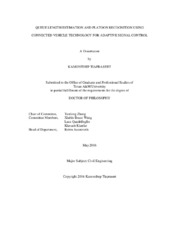| dc.contributor.advisor | Zhang, Yunlong | |
| dc.creator | Tiaprasert, Kamonthep | |
| dc.date.accessioned | 2016-07-08T15:06:42Z | |
| dc.date.available | 2018-05-01T05:49:57Z | |
| dc.date.created | 2016-05 | |
| dc.date.issued | 2016-01-11 | |
| dc.date.submitted | May 2016 | |
| dc.identifier.uri | https://hdl.handle.net/1969.1/156829 | |
| dc.description.abstract | This dissertation presents mathematical and analytical models for real-time queue length estimation and platoon recognition using the connected vehicle technology (CVT). Information on queue length and platoon is a crucial part of traffic signal control and is difficult to obtain accurately with traditional technologies such as loop detectors. The past studies are either limited to fixed-time signal control or lacked verification on the applicable range or evaluation of the performance of algorithms.
The proposed algorithms focused on estimating the queue length for adaptive signal control and platoon characteristics for signal coordination and adaptive signal control. For queue length detection, an algorithm was developed to determine the estimated value between the last stopped vehicle and the first moving vehicle for different market penetration ratios. Discrete wavelet transform is applied to the estimated queue lengths to improve accuracy and consistency.
The platoon recognition model is developed based on time headway so that the arrival times can be computed directly from the estimated platoon data. First, the detected platoon is identified by a modified critical time-headway. Then, platoon size and starting and ending times are estimated. Lastly, a filtering process for “qualified” detected platoon is proposed to optimize detectability. The results show that the proposed algorithms can estimate well in various traffic conditions and under both fixed-time and actuated signal control without relying on inputs that are hard to obtain in practice. Furthermore, an analytical model to estimate the platoon detection rate is proposed and shown to be close to the numerical results. Therefore, Traffic engineers can use the analytical model to estimate the required market penetration ratio for the application without field experiments or microscopic simulation. Accordingly, the proposed algorithms can be an important part of adaptive signal control focusing on real-time coordination. | en |
| dc.format.mimetype | application/pdf | |
| dc.language.iso | en | |
| dc.subject | Queue Length Estimation | en |
| dc.subject | Wireless Vehicle-To-Vehicle Communications | en |
| dc.subject | Adaptive Signal Control | en |
| dc.subject | Discrete Wavelet Transform | en |
| dc.subject | Platoon Identification | en |
| dc.title | Queue Length Estimation and Platoon Recognition Using Connected Vehicle Technology for Adaptive Signal Control | en |
| dc.type | Thesis | en |
| thesis.degree.department | Civil Engineering | en |
| thesis.degree.discipline | Civil Engineering | en |
| thesis.degree.grantor | Texas A & M University | en |
| thesis.degree.name | Doctor of Philosophy | en |
| thesis.degree.level | Doctoral | en |
| dc.contributor.committeeMember | Wang, Xiubin Bruce | |
| dc.contributor.committeeMember | Quadrifoglio, Luca | |
| dc.contributor.committeeMember | Kianfar, Kiavash | |
| dc.type.material | text | en |
| dc.date.updated | 2016-07-08T15:06:42Z | |
| local.embargo.terms | 2018-05-01 | |
| local.etdauthor.orcid | 0000-0001-9169-1836 | |


